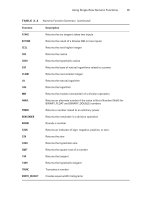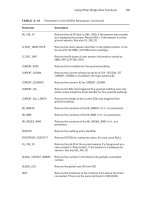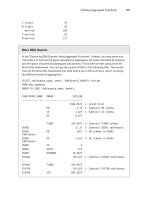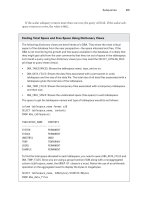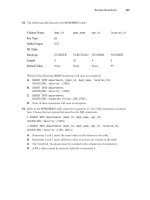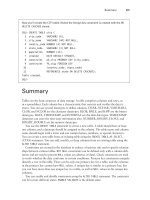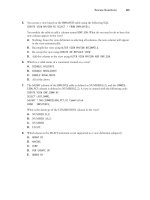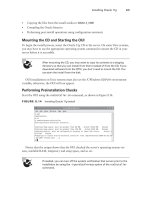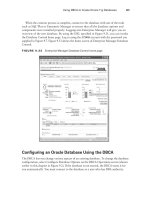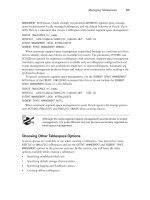Tài liệu OCA: Oracle Database 11g Administrator Certified Associate- P10 pptx
Bạn đang xem bản rút gọn của tài liệu. Xem và tải ngay bản đầy đủ của tài liệu tại đây (1.01 MB, 50 trang )
Review Questions
381
5. You create a view based on the EMPLOYEES table using the following SQL.
CREATE VIEW MYVIEW AS SELECT * FROM EMPLOYEES;
You modify the table to add a column named EMP_SSN. What do you need to do to have this
new column appear in the view?
A. Nothing. Since the view definition is selecting all columns, the new column will appear
in the view automatically.
B. Recompile the view using ALTER VIEW MYVIEW RECOMPILE.
C. Re-create the view using CREATE OR REPLACE VIEW.
D. Add the column to the view using ALTER VIEW MYVIEW ADD EMP_SSN.
6. Which is a valid status of a constraint created on a view?
A. DISABLE VALIDATE
B. DISABLE NOVALIDATE
C. ENABLE NOVALIDATE
D. All of the above
7. The SALARY column of the EMPLOYEE table is defined as NUMBER(8,2), and the COMMIS-
SION_PCT column is defined as NUMBER(2,2). A view is created with the following code:
CREATE VIEW EMP_COMM AS
SELECT LAST_NAME,
SALARY * NVL(COMMISSION_PCT,0) Commission
FROM EMPLOYEES;
What is the datatype of the COMMISSION column in the view?
A. NUMBER (8,2)
B. NUMBER (10,2)
C. NUMBER
D. FLOAT
8. Which clause in the SELECT statement is not supported in a view definition subquery?
A. GROUP BY
B. HAVING
C. CUBE
D. FOR UPDATE OF
E. ORDER BY
95127c07.indd 381 2/17/09 12:33:21 PM
Please purchase PDF Split-Merge on www.verypdf.com to remove this watermark.
382
Chapter 7
N
Creating Schema Objects
9. The EMPLOYEE table has the following columns:
EMP_ID NUMBER (4)
EMP_NAME VARCHAR2 (30)
SALARY NUMBER (6,2)
DEPT_ID VARCHAR2 (2)
Which query will show the top five highest-paid employees?
A. SELECT * FROM
(SELECT EMP_NAME, SALARY
FROM EMPLOYEE
ORDER BY SALARY ASC)
WHERE ROWNUM <= 5;
B. SELECT EMP_NAME, SALARY FROM
(SELECT *
FROM EMPLOYEE
ORDER BY SALARY DESC)
WHERE ROWNUM < 5;
C. SELECT * FROM
(SELECT EMP_NAME, SALARY
FROM EMPLOYEE
ORDER BY SALARY DESC)
WHERE ROWNUM <= 5;
D. SELECT EMP_NAME, SALARY
(SELECT *
FROM EMPLOYEE
ORDER BY SALARY DESC)
WHERE ROWNUM = 5;
95127c07.indd 382 2/17/09 12:33:21 PM
Please purchase PDF Split-Merge on www.verypdf.com to remove this watermark.
Review Questions
383
10. The EMPLOYEE table has the following columns:
EMP_ID NUMBER (4) PRIMARY KEY
EMP_NAME VARCHAR2 (30)
SALARY NUMBER (6,2)
DEPT_ID VARCHAR2 (2)
A view is defined using the following SQL:
CREATE VIEW EMP_IN_DEPT10 AS
SELECT * FROM EMPLOYEE
WHERE DEPT_ID = ‘HR’;
Which INSERT statement will succeed through the view?
A. INSERT INTO EMP_IN_DEPT10 VALUES (1000, ‘JOHN’,1500,’HR’);
B. INSERT INTO EMP_IN_DEPT10 VALUES (1001, NULL,1700,’AM’);
C. INSERT INTO EMP_IN_DEPT10 VALUES (1002, ‘BILL’,2500,’AC’);
D. All of the above
11. To be able to modify a join view, the view definition should not contain which of the fol-
lowing in the top-level query? (Choose all that apply.)
A. A DISTINCT operator
B. An ORDER BY clause
C. Aggregate functions such as SUM, AVG, and COUNT
D. A WHERE clause
E. A GROUP BY clause
F. A ROWNUM pseudocolumn
12. Which statement will create a sequence that starts with 0 and gets smaller one whole num-
ber at a time?
A. create sequence desc_seq start with 0 increment by -1 maxvalue 1;
B. create sequence desc_seq increment by -1;
C. create sequence desc_seq start with 0 increment by -1;
D. Sequences can only increase.
13. Which statement is most correct in describing what happens to a synonym when the under-
lying object is dropped?
A. The synonym’s status is changed to INVALID.
B. You can’t drop the underlying object if a synonym exists unless the CASCADE clause is
used in the DROP statement.
C. The synonym is automatically dropped with the underlying object.
D. Nothing happens to the synonym.
95127c07.indd 383 2/17/09 12:33:21 PM
Please purchase PDF Split-Merge on www.verypdf.com to remove this watermark.
384
Chapter 7
N
Creating Schema Objects
14. There is a public synonym named PLAN_TABLE for SYSTEM.PLAN_TABLE. Which of the fol-
lowing statements will remove this public synonym from the database?
A. drop table system.plan_table;
B. drop synonym plan_table;
C. drop table system.plan_table cascade;
D. drop public synonym plan_table;
15. A developer reports that she is receiving the following error:
SELECT key_seq.currval FROM dual;
ERROR at line 1:
ORA-08002: sequence KEY_SEQ.CURRVAL is not yet defined
Which of the following statements does the developer need to run to fix this condition?
A. create sequence key_seq;
B. create synonym key_seq;
C. select key_seq.nextval from dual;
D. grant create sequence to public;
16. Bitmapped indexes are best suited to which type of environment?
A. High-cardinality columns
B. Online transaction processing (OLTP) applications
C. Full-table scan access
D. Low- to medium-cardinality columns
17. Which clauses in a SELECT statement can an index be used for? (Choose all that apply.)
A. SELECT
B. FROM
C. WHERE
D. HAVING
95127c07.indd 384 2/17/09 12:33:21 PM
Please purchase PDF Split-Merge on www.verypdf.com to remove this watermark.
Review Questions
385
18. You need to generate artificial keys for each row inserted into the PRODUCTS table. You
want the first row to use a sequence value of 1000, and you want to make sure that no
sequence value is skipped. Which of the following statements will meet these requirements?
A. CREATE SEQUENCE product_key2
START WITH 1000
INCREMENT BY 1
NOCACHE;
B. CREATE SEQUENCE product_key2
START WITH 1000
NOCACHE;
C. CREATE SEQUENCE product_key2
START WITH 1000
NEXTVAL 1
NOCACHE;
D. Options A and B meet the requirements.
E. None of the above statements meet all the requirements.
19. Which statement will display the last number generated from the EMP_SEQ sequence?
A. select emp_seq.curr_val from dual;
B. select emp_seq.currval from dual;
C. select emp_seq.lastval from dual;
D. select last_number from all_sequences where sequence_name =’EMP_SEQ’;
E. You cannot get the last sequence number generated.
20. Which statement will create a sequence that will rotate through 100 values in a round-robin
manner?
A. create sequence roundrobin cycle maxvalue 100;
B. create sequence roundrobin cycle to 100;
C. create sequence max_value 100 roundrobin cycle;
D. create rotating sequence roundrobin min 1 max 100;
95127c07.indd 385 2/17/09 12:33:21 PM
Please purchase PDF Split-Merge on www.verypdf.com to remove this watermark.
386
Chapter 7
N
Creating Schema Objects
Answers to Review Questions
1. B. A view is dropped using the DROP VIEW view_name; command.
2. A. You can perform an INSERT, UPDATE, or DELETE operation on the columns involving
only one base table at a time. There are also some restrictions on the DML operations you
perform on a join view.
3. D. Since the view definition includes a DISTINCT clause, only queries are allowed on the
view.
4. B, E. The OR REPLACE option in the CREATE VIEW statement is used to modify the defini-
tion of the view. The FORCE option can be used to create the view with errors. The ALTER
VIEW statement is used to compile a view or to add or modify constraints on the view.
5. C. When you modify the base table, the view becomes invalid. Oracle will recompile the
view the first time it is accessed. Recompiling the view will make it valid, but the new col-
umn will not be available in the view. This is because when you create the view using *,
Oracle expands the column names and stores the column names in the dictionary.
6. B. Since the constraints on the view are not enforced by Oracle, the only valid status of a
constraint can be DISABLE NOVALIDATE. You must specify this status when creating con-
straints on a view.
7. C. When numeric operations are performed using numeric datatypes in the view definition,
the resulting column will be a floating datatype, which is NUMBER without any precision
or scale.
8. D. The FOR UPDATE OF clause is not supported in the view definition. The FOR UPDATE
clause locks the rows, so it is not allowed.
9. C. You can find the top five salaries using an inline view with the ORDER BY clause. The
Oracle 11g Optimizer understands the top-n rows query. Option B would have been correct
if you had ROWNUM <= 5 in the WHERE clause.
10. D. The view is based on a single table, and the only constraint on the table is the primary
key. Although the view is defined with a WHERE clause, you have not enforced that check
while using DML statements through the WITH CHECK OPTION clause.
11. A, C, E, F. To be able to update a base table using the view, the view definition should not
have a DISTINCT clause, a GROUP BY clause, a START WITH clause, a CONNECT BY clause,
ROWNUM, set operators (UNION, UNION ALL, INTERSECT, or MINUS), or a subquery in the
SELECT clause.
12. A. For a descending sequence, the default START WITH value is –1, and the default MAXVALUE
value is –1. To start the sequence with 0, you must explicitly override both of these defaults.
13. A. When the underlying object is dropped, the synonym will become INVALID. You can see
the status of the synonym by querying the USER_OBJECTS dictionary view.
95127c07.indd 386 2/17/09 12:33:21 PM
Please purchase PDF Split-Merge on www.verypdf.com to remove this watermark.
Answers to Review Questions
387
14. D. To remove a public synonym, use the DROP PUBLIC SYNONYM statement. The DROP
TABLE statement will remove a table from the database but will not drop any synonyms on
the table. The synonym will become invalid.
15. C. A sequence is not yet initialized if NEXTVAL has not yet been selected from it within the
current session. It has nothing to do with creating a sequence, creating a synonym, or grant-
ing privileges.
16. D. Bitmapped indexes are not suited for high-cardinality columns (those with highly selec-
tive data). OLTP applications tend to need row-level locking, which is not available with
bitmap indexes. Full-table scans do not use indexes. Bitmap indexes are best suited to multiple
combinations of low- to medium-cardinality columns.
17. A, C. The obvious answer is C, but an index also can be used for the SELECT clause. If an
index contains all the columns needed to satisfy the query, the table does not need to be
accessed.
18. D. Both options A and B produce identical results, because the INCREMENT BY 1 clause is
the default if it is not specified. Option C is invalid because NEXTVAL is not a valid keyword
within a CREATE SEQUENCE statement.
19. B. Option D is close, but it shows the greatest number in the cache, not the latest generated.
The correct answer is from the sequence itself, using the pseudocolumn CURRVAL.
20. A. The keyword CYCLE will cause the sequence to wrap and reuse numbers. The keyword
MAXVALUE will set the largest value the sequence will cycle to. The name roundrobin is
there to confuse to you.
95127c07.indd 387 2/17/09 12:33:22 PM
Please purchase PDF Split-Merge on www.verypdf.com to remove this watermark.
95127c07.indd 388 2/17/09 12:33:22 PM
Please purchase PDF Split-Merge on www.verypdf.com to remove this watermark.
PART
II
Oracle
Database 11g:
Administration I
95127c08.indd 389 2/17/09 12:45:14 PM
Please purchase PDF Split-Merge on www.verypdf.com to remove this watermark.
95127c08.indd 390 2/17/09 12:45:15 PM
Please purchase PDF Split-Merge on www.verypdf.com to remove this watermark.
Chapter
8
Introducing Oracle
Database 11g
Components and
Architecture
ORACLE DATABASE 11g:
ADMINISTRATION I EXAM OBJECTIVES
COVERED IN THIS CHAPTER:
Exploring the Oracle Database Architecture
Explain the Memory Structures
Describe the Process Structures
Overview of Storage Structures
Preparing the Database Environment
Identify the tools for Administering an Oracle Database
Plan an Oracle Database installation
Install the Oracle software by using Oracle Universal
Installer (OUI)
95127c08.indd 391 2/17/09 12:45:15 PM
Please purchase PDF Split-Merge on www.verypdf.com to remove this watermark.
With this chapter, you’ll start learning Oracle Database 11g
(Oracle 11g) database administration. This chapter and the
remaining chapters of the book will discuss the objectives for
the Oracle 11g Administration I OCA certification exam.
With the release of Oracle 11g, Oracle Corporation has delivered a powerful and feature-
rich database that can meet the performance, availability, recoverability, application-testing,
and security requirements of any mission-critical application. As the Oracle DBA, you are
responsible for managing and maintaining the Oracle Database 11g throughout its life
cycle, from initial installation, creation, and configuration to final deployment. Perform-
ing these tasks requires a solid understanding of Oracle’s product offerings so that you
can apply the proper tools and features to the application. You must also use relational
database concepts to design, implement, and maintain the tables that store the application
data. At the heart of these activities is the need for a thorough understanding of the Oracle
architecture and the tools and techniques used to monitor and manage the components of
this architecture.
I will begin the chapter by reviewing the Oracle Database basics. You will learn what con-
stitutes the Oracle Database 11g—an overview of the memory structures, the processes that
manage the database, and how data is stored in the database. I will also discuss the tools used
to administer the Oracle Database 11g and how to install the Oracle 11g software.
Exam objectives are subject to change at any time without prior notice
and at Oracle’s sole discretion. Please visit Oracle’s Training and Certifica-
tion website at
/>db_pages.getpage?page_id=41&p_exam_id=1Z0_052
for the most current
exam-objectives listing.
Oracle Database Fundamentals
Databases store data. The data itself is composed of related logical units of information.
The database management system (DBMS) facilitates the storage, modification, and
retrieval of this data. Some early database technologies used flat files or hierarchical file
structures to store application data. Others used networks of connections between sets
of data to store and locate information. The early DBMS architecture mixed the physical
manipulation of data with its logical manipulation. When the location of data changed, the
95127c08.indd 392 2/17/09 12:45:15 PM
Please purchase PDF Split-Merge on www.verypdf.com to remove this watermark.
Oracle Database Fundamentals
393
application referencing the data had to be updated. Relational databases brought a revolu-
tionary change to this architecture. Relational DBMS introduced data independence, which
separated the physical model of the data from its logical model. Oracle is a relational DBMS.
All releases of Oracle’s database products have used a relational DBMS model to store
data in the database. This relational model is based on the groundbreaking work of Dr.
Edgar Codd, which was first published in 1970 in his paper “A Relational Model of Data
for Large Shared Data Banks.” IBM Corporation, which was then an early adopter of Dr.
Codd’s model, helped develop the computer language that is used to access all relational
databases today—Structured Query Language (SQL). The great thing about SQL is that
you can use it to easily interact with relational databases without having to write complex
computer programs and without needing to know where or how the data is physically
stored on disk. You saw several SQL statements in the previous chapters.
Relational Databases
The concept of a relational database management system (RDBMS) is that the data con-
sists of a set of relational objects. The basic storage of data in a database is a table. The
relations are implemented in tables, where data is stored in rows and columns. Figure 8.1
shows such a relationship.
FIGURE 8.1 Relational tables
EMP (Employee Table)
EMPNO
7369
7499
7521
7566
7654
7698
7844
ENAME
SMITH
ALLEN
WARD
JONES
MARTIN
BLAKE
URNER
JOB
CLERK
SALESMAN
SALESMAN
MANAGER
SALESMAN
MANAGER
SALESMAN
MGR
7902
7698
7698
7839
7698
7839
7698
HIREDATE
17-DEC -8
20-FEB-8
22-FEB-8
02-APR-8
28-SEP-8
07-MAY-8
08-SEP-8
0800
11600
11250
12975
11250
12850
11500
COMM DEPTNO
20
30
30
20
30
30
30
300
500
1400
Primary Key
Column
Primary Key
Column
Foreign Key
Column
DEPT (Department Table)
DNAME
ACCOUNTING
RESEARCH
SALES
OPERATIONS
DEPTNO
10
20
30
40
LOC
NEW YORK
DALLAS
CHICAGO
BOSTON
SAL
95127c08.indd 393 2/17/09 12:45:16 PM
Please purchase PDF Split-Merge on www.verypdf.com to remove this watermark.
394
Chapter 8
Introducing Oracle Database 11g Components and Architecture
The
DEPT
table in the lower part of the figure stores information about departments
in the company. Each department is identified by the department ID. Along with the ID,
the name and location of the department are also stored in the table. The
EMP
table stores
information about the employees in the company. Each employee is identified by a unique
employee ID. This table includes employee information such as hire date, salary, manager,
and so on. The
DEPTNO
column in both tables then provides a relationship between the
tables. A department may have many employees, but an employee can work for only one
department.
Since the user accessing this data doesn’t need to know how or where the row is stored
in the database, there must be a way to uniquely identify the rows in the tables. In our
example, the department is uniquely identified by department number, and an employee is
identified by an employee ID. The column (or set of columns) that uniquely identifies a row
is known as the primary key. According to relational theory, each table in a relational data-
base must have a primary key.
When relating tables together, the primary key of one table is placed in another table.
For example, the primary key of the
DEPT
table is a column in the
EMP
table. In RDBMS
terminology, this is known as a foreign key. A foreign key states that the data value in the
column exists in another table and should continue to exist in the other table to keep the
relationship between tables. The table where the column is a primary key is known as the
parent table, and the table where the foreign key column exists is known as the child table.
Oracle enforces the parent-child relationship between tables using constraints.
Oracle Database 11g Objects
Every RDBMS supports a variety of database objects. Oracle 11g supports the entire set of
database objects required for a relational database, such as tables, views, constraints, and
so on. It also supports a wide range of objects specific to the Oracle Database 11g, such as
packages, sequences, materialized views, and so on. Table 8.1 lists the objects available in
Oracle 11g. I also discussed many of these in Chapter 6, “Creating Tables and Constraints,”
and Chapter 7, “Creating Schema Objects.”
TABLE 8.1 Oracle Database 11g Objects
Object Type Description
Table A table is the basic form of data storage. A table has columns and
stores rows of data.
View
A view is a stored query. No data-storage space is occupied for view data.
Index An index is an optional structure that is useful for locating data faster.
Materialized view Materialized views are used to summarize and store data. They are
similar to views but take up storage space to store data.
95127c08.indd 394 2/17/09 12:45:16 PM
Please purchase PDF Split-Merge on www.verypdf.com to remove this watermark.
Oracle Database Fundamentals
395
Object Type Description
Index-organized
table
An index-organized table use a primary key and stores the table data
in the index segment.
Cluster A cluster is a group of tables that share the same storage blocks.
Constraint A constraint is a stored rule to enforce data integrity.
Sequence A sequence provides a mechanism for the continuous generation of
numbers.
Synonym A synonym is an alias for a database schema object.
Triggers A trigger is a PL/SQL program unit that gets executed when an event
occurs.
Stored function Stored functions are PL/SQL programs that can be used to create
user-defined functions to return a value.
Stored procedure Stored procedures are PL/SQL programs to define a business
process.
Package A package is a collection of procedures, functions, and other program
constructs.
Java Stored Java procedures can be created in Oracle to define business
processes.
Database link Database links are used to communicate between databases to
share data.
You use SQL to create database objects and to interact with application data. In the next
section, I will discuss the tools available to access and administer Oracle 11g database.
Interacting with Oracle 11g
SQL is the language used to interact with the Oracle 11g database. Many tools are available
for the DBA to administer an Oracle 11g database. The common tools are as follows:
SQL*Plus, which is a command-line interface utility
SQL Developer, a GUI tool
Oracle Enterprise Manager Database Control, a GUI tool
TABLE 8.1 Oracle Database 11g Objects (continued)
95127c08.indd 395 2/17/09 12:45:16 PM
Please purchase PDF Split-Merge on www.verypdf.com to remove this watermark.
396
Chapter 8
Introducing Oracle Database 11g Components and Architecture
Using SQL*Plus and SQL Developer, you interact directly with the Oracle 11g database
using SQL statements and a superset of commands such as
STARTUP
,
SHUTDOWN
, and so on.
Using Enterprise Manager, you interact indirectly with the Oracle 11g database.
SQL*Plus
SQL*Plus is the primary tool for an Oracle DBA to administer the database using SQL
commands. Before you can run SQL statements, you must connect to the Oracle 11g data-
base. You can start SQL*Plus from a Windows command prompt using the
SQLPLUS.EXE
executable or using the
$ORACLE_HOME/bin/sqlplus
executable on the Unix/Linux plat-
form. Figure 8.2 shows connecting to SQL*Plus from a Linux workstation.
FIGURE 8.2 SQL*Plus login in Linux
To get an overview of SQL*Plus and how to connect to the database using SQL*Plus,
please refer to Chapter 1, “Introducing SQL.”
SQL Developer
SQL Developer is a free GUI database-development tool. With SQL Developer, you can
create and view the database objects, make changes to the objects, run SQL statements,
run PL/SQL programs, create and edit PL/SQL programs, and perform PL/SQL debugging.
95127c08.indd 396 2/17/09 12:45:16 PM
Please purchase PDF Split-Merge on www.verypdf.com to remove this watermark.
Oracle Database Fundamentals
397
SQL Developer also includes a migration utility to migrate Microsoft Access and Microsoft
SQL Server databases to Oracle 11g. Figure 8.3 shows the object browser screen of SQL
Developer.
FIGURE 8.3 SQL Developer screen
You can download and learn more about SQL Developer on the OTN
website (
/>developer/index.html
).
Enterprise Manager Database Control
Oracle Enterprise Manager Database Control is a web-based database management tool
that is bundled with the Oracle 11g database. This is a graphical tool specifically designed
to administer the Oracle database. The Enterprise Manager Database Control is used to man-
age a single database, whereas the Enterprise Manager Grid Control can manage multiple
databases and other services and applications, such as OAS, and even non-Oracle applica-
tions at the same time. Figure 8.4 shows the Enterprise Manager Database Control home
screen, where an overview of the database is shown.
95127c08.indd 397 2/17/09 12:45:16 PM
Please purchase PDF Split-Merge on www.verypdf.com to remove this watermark.
398
Chapter 8
Introducing Oracle Database 11g Components and Architecture
FIGURE 8.4 Enterprise Manager home screen
For all the database-administration examples in this chapter, you may use either SQL*Plus
to perform the SQL command line or use the GUI tool Enterprise Manager (EM) Database
Control. Before learning to administer the Oracle 11g database, let’s start with the basics.
In the next section, you’ll learn about Oracle 11g architecture.
Oracle 11g Architecture
Each database-administration and -development tool described previously allows a user
to interact with the database. Using these tools requires that user accounts be created in
the database and that connectivity to the database be in place across the network. Users
must also have adequate storage capacity for the data they insert, and they need recovery
mechanisms for restoring the transactions they are performing in the event of a hardware
95127c08.indd 398 2/17/09 12:45:16 PM
Please purchase PDF Split-Merge on www.verypdf.com to remove this watermark.
Oracle 11g Architecture
399
failure. As the DBA, you take care of each of these tasks, as well as others, which include
the following:
Selecting the server hardware on which the database software will run
Installing and configuring the Oracle 11
g software on the server hardware
Creating the Oracle 11
g database
Creating and managing the tables and other objects used to manage the application data
Creating and managing database users
Establishing reliable backup and recovery processes for the database
Monitoring and tuning database performance
The remainder of this book is dedicated to helping you understand how to perform these
and other important Oracle database-administration tasks. But first, to succeed as an Oracle
DBA, you need to completely understand Oracle’s underlying architecture and its mechanisms.
Understanding the relationship between Oracle’s memory structures, background processes,
and I/O activities is critical before learning how to manage these areas.
The Oracle server architecture can be described in three categories:
User-related processes
Logical memory structures that are collectively called an
Oracle instance
Physical file structures that are collectively called a
database
You will also see how the physical structures map to the logical structures of the data-
base you are familiar with, such as tables and indexes.
Database is a confusing term that is often used to represent different things on different
platforms; the only commonality is that it is something related to storing data. In Oracle,
however, the term database represents the physical files that store data. An instance is com-
posed of the memory structures and background processes. Each database should have at
least one instance associated with it. It is possible for multiple instances to access a single
database; such a configuration is known as Real Application Clusters (RAC). In this book,
however, you’ll concentrate only on single-instance databases because RAC is not part of
the certification exam.
Figure 8.5 shows all the parts of an Oracle instance and database.
Although the architecture in Figure 8.5 may at first seem complex, each of these archi-
tecture components is described in more detail in the following sections, beginning with
the user-related processes, and is actually fairly simple. This figure is an important piece of
fundamental information when learning about the Oracle 11g architecture.
The key database components are memory structures, process structures,
and storage structures. Process and memory structures together are called
an instance; the storage structure is called a database. Taken together, the
instance and the database are called an Oracle server.
95127c08.indd 399 2/17/09 12:45:17 PM
Please purchase PDF Split-Merge on www.verypdf.com to remove this watermark.
400
Chapter 8
Introducing Oracle Database 11g Components and Architecture
FIGURE 8.5 The Oracle 11g architecture
Server
Process 1
PGA
Datafile 1 Datafile 2 Datafile 3 Datafile 4 Datafile 5
Tablespace
1
SGA
Server
Process 2
Background
Processes
PGA
Instance
Physical
Database
Structure
DBWn CKPT LGWR
Database
Data
Files
Control
Files
Redo Log
Files
Database
Archive Log
Files
Password
Files
Parameter
Files
Logical
Database
Structure
SYSTEM
Tablespace
SYSAUX
Tablespace
Tablespace
2
User Processes
At the user level, two types of processes allow a user to interact with the instance and, ulti-
mately, with the database: the user process and the server process.
Whenever a user runs an application, such as a human-resources or order-taking applica-
tion, Oracle starts a user process to support the user’s connection to the instance. Depending
on the technical architecture of the application, the user process exists either on the user’s
own computer or on the middle-tier application server. The user process then initiates a con-
nection to the instance. Oracle calls the process of initiating and maintaining communication
between the user process and the instance a connection. Once the connection is made, the
user establishes a session in the instance.
After establishing a session, each user starts a server process on the host server itself.
It is this server process that is responsible for performing the tasks that actually allow the
user to interact with the database.
95127c08.indd 400 2/17/09 12:45:17 PM
Please purchase PDF Split-Merge on www.verypdf.com to remove this watermark.
